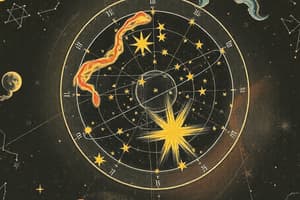Podcast
Questions and Answers
What are stars?
What are stars?
- Gaseous bodies that emit light due to their proximity to the sun
- Hot, luminous celestial bodies that produce their own light through nuclear reactions (correct)
- Solid bodies that emit light due to their fusion with hydrogen
- Cold, dark celestial bodies that reflect light from other stars
How can brightness of a star be described?
How can brightness of a star be described?
- Based on the number of planets orbiting around it
- Based on proximity to other stars
- Based on its distance from Earth
- Based on luminosity and magnitude (correct)
What does the color of a star depend on?
What does the color of a star depend on?
- The star's age
- The star's surface temperature (correct)
- The star's size
- The star's distance from Earth
What is the sun's color and type of star?
What is the sun's color and type of star?
What does the brightness of a star depend on?
What does the brightness of a star depend on?
What is the basic characteristic of stars related to their mass?
What is the basic characteristic of stars related to their mass?
What is the primary factor determining a star's color?
What is the primary factor determining a star's color?
What does a star's luminosity measure?
What does a star's luminosity measure?
What is the process through which the sun produces light and heat energy?
What is the process through which the sun produces light and heat energy?
How can a larger star's brightness be described compared to a smaller star?
How can a larger star's brightness be described compared to a smaller star?
Flashcards are hidden until you start studying




